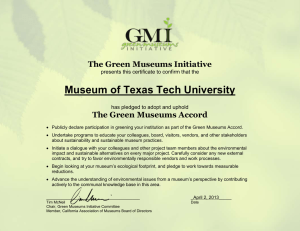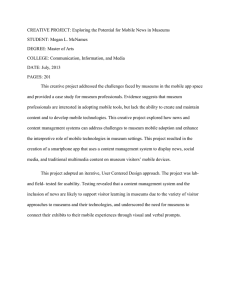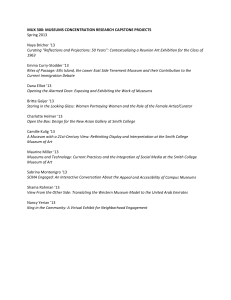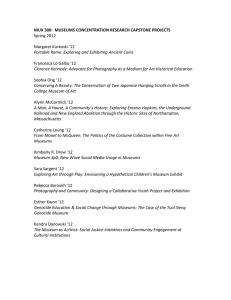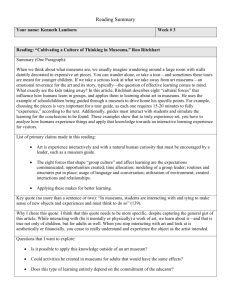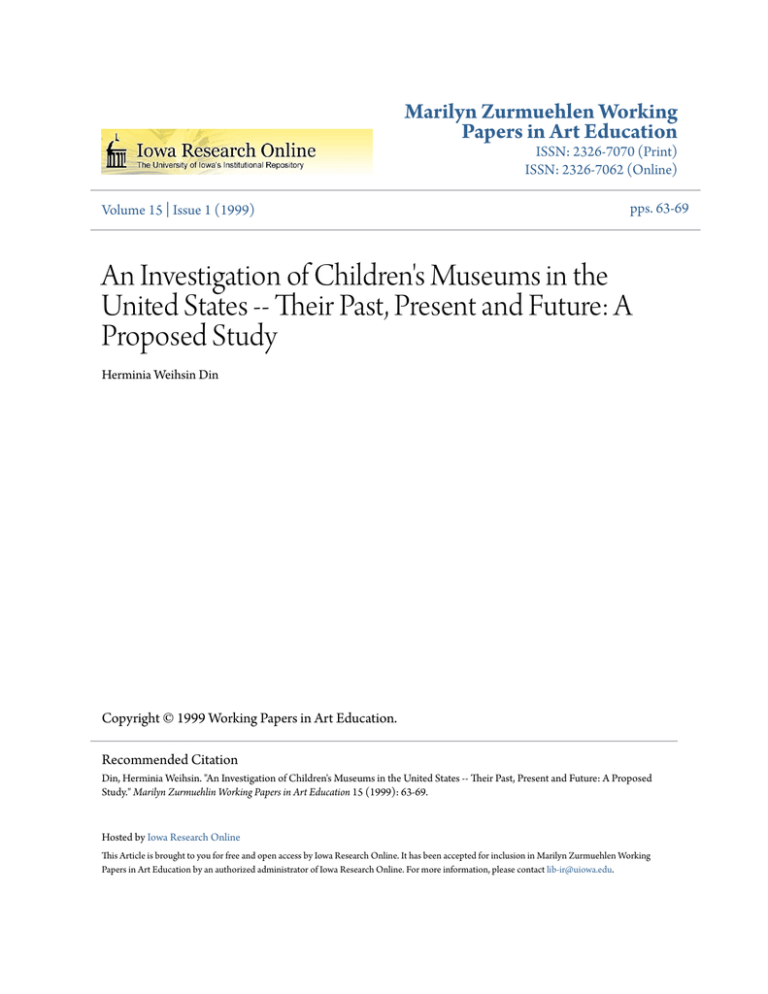
Marilyn Zurmuehlen Working
Papers in Art Education
ISSN: 2326-7070 (Print)
ISSN: 2326-7062 (Online)
Volume 15 | Issue 1 (1999)
pps. 63-69
An Investigation of Children's Museums in the
United States -- Their Past, Present and Future: A
Proposed Study
Herminia Weihsin Din
Copyright © 1999 Working Papers in Art Education.
Recommended Citation
Din, Herminia Weihsin. "An Investigation of Children's Museums in the United States -- Their Past, Present and Future: A Proposed
Study." Marilyn Zurmuehlin Working Papers in Art Education 15 (1999): 63-69.
Hosted by Iowa Research Online
This Article is brought to you for free and open access by Iowa Research Online. It has been accepted for inclusion in Marilyn Zurmuehlen Working
Papers in Art Education by an authorized administrator of Iowa Research Online. For more information, please contact lib-ir@uiowa.edu.
Din: An Investigation of Children's Museums in the United States -- Their Past, Present and Future
An Investigation of Children’s Museums
in the United States -- Their Past, Present and Future:
A Proposed Study
Herminia Weihsin Din
Introduction
Most American museums in the middle of the nineteenth century were
established for the purposes of collection, preservation, and exhibition of art,
natural specimens, and cultural artifacts. These traditional museums encouraged
learning through passive listening and seeing, and not by interaction with the
object. They were designed primarily for adults' interests and children were
expected to visit the museums and enjoy them as adults did. There was nothing
special or unique for children until the Brooklyn Children's Museum opened its
doors on December 16, 1899. This museum was dedicated as a place especially
for children to learn, to discover, and to satisfy their natural curiosity. Its opening
marked the beginning of the development of children's museums in the United
States.
Copyright
All Rights Reserved
Across one hundred years of history, the evolution of children's
museums has been enthusiastically supported and recognized by parents,
educators, community leaders, and boards of education, and all were involved in
the development of children's museums. Consequently, there was a continuing
demand for the establishment of children's museums, which became the fastest
growing branch of the museum community. For instance, there were over 40
children's museums, youth museums or junior museums by the 1960s. The
number doubled during the 1970s and 1980s and more than 70 children's
museums have opened to the public between 1990 and 1997. About a dozen
children's museums are scheduled to open in the next five years.
A review of the literature discovered few studies that focus on the
context of children's museums development, while comparatively more studies
are available regarding descriptive information or historical facts. For instance,
Selina Johnson had investigated the origins, relationships, and cultural
contributions of museums for youth in the United States in 1962.1 However, this
study was finished before the revolution of children's museum movement, when
Michael Spock, who became the head of the Children's Museum in Boston in
1963, redefined the philosophy of children's museums and promoted
participatory and interactive learning.2 Several other studies focused on the
dynamics of selected children's museums, the development and status of
science centers and museums for children, school museums in the United
States, examination of selected characteristics of hands-on children's museum,
and so on.3 This lack of extended research within the context of children's
museums development suggests a need for further in-depth research
investigation in the area.4
Copyright
All Rights Reserved
_______________________________________________________
Marilyn Zurmuehlen’s Working Papers In Art Education 1998-1999
http://ir.uiowa.edu/mzwp/vol15/iss1/13
63
Marilyn Zurmuehlen Working Papers in Art Education, Vol. 15 [1999], Art. 13
Purpose of the Study
The purpose of this study is to identify how changes in educational
theories, social, and cultural issues have affected the movement of children's
museums during its almost one hundred years of evolution. In order to
understand the broad context within which children's museum development
occurred, this study intends to present a history of the children's museum
movement in general, instead of specifying the development of each individual
museum.
This study also addresses the potential and importance of children's
museums and their connection to the principles and delivery of art education and
museum education in art museums. As we know, a central concept of teaching
the arts is to create a learning experience that is meaningful for students by
incorporating knowledge across art history, criticism, aesthetics, studio
production, and cultural aspects. In order to make the learning process more
interesting, more relevant, and more rewarding, the foundation of teaching art is
to facilitate students to make connections from one idea to another, especially in
relation to their lives. Art education relies on student-centered pedagogies.
Copyright
All Rights Reserved
The ideology at the children's museum is parallel to the discipline of art
education. Generally, children's museum practices reflect the philosophy of
"learning by doing," engage contextual understanding, emphasize participatory
learning experience, focus on a thematic approach in programming and exhibition
design, promote cultural diversity, and provide community services. Children's
museums are designed specifically for children to learn, to spark their curiosity
and imagination, and to have a holistic understanding of themselves and the
world around them. Therefore, a study of the history of children's museums can
add to the body of knowledge regarding the causal relationship among social,
cultural, and political forces affecting art education and museum education in art
museums.
Research Questions
Copyright
All Rights Reserved
The primary research goal of this study is to understand what a children's
museum is and its relation to educational, social, and cultural issues that have
affected the development of children's museums by examining the following
research questions:
1. What were the motivations and initiatives for developing children's museums?
2. How have educational theories, social, and cultural issues affected the
development of children's museums?
3. What were the reasons for the rapid growth in children's museums after the
1960s?
4. How have been the philosophies of exhibition design changed through the
historical development of children's museums?
5. What are the congruencies among the discipline of art education, museum
education in art museums, and children's museum practices?
_______________________________________________________
Marilyn Zurmuehlen’s Working Papers In Art Education 1998-1999
http://ir.uiowa.edu/mzwp/vol15/iss1/13
64
Din: An Investigation of Children's Museums in the United States -- Their Past, Present and Future
Methodology
According to Walter Borg and Meredith Gall, "historical research involves
the systematic search for facts relating to questions about the past and the
interpretation of these facts."5 Foster Wygant also believes that historical
research can describe the main research target not only in terms of an overview of
the beginning and introduction of its main developments, but can also examine
these movements in a variety of contexts.6 Therefore, this study was conducted
as historical research in the period between 1899 and 1997 to draw a picture of
how the children's museums evolved in the United States. To achieve a better
understanding of the context of the children's museum movement, the research
procedures of this study were identified as follows:
Copyright
All Rights Reserved
The first step was to define the research population by cross-examining
various resources as the Museum Index, Association of Youth Museum
Membership Directory, etc. Two basic categories--"children's museum" and
"open to the public"--were used to prepare a chronological list of children's
museums. Under these two categories, there were approximately 200 children's
museums selected to be a part of this study. Although some of these museums
had closed, merged, or changed their name and/or focus to become different
types of institutions over the course of their existence.
Data used for this study were gathered mainly from primary resources
such as information provided directly by children's museums and archival
documents related to children's museum development. Due to the massive
quantity of data, this study applied external and internal criticism to evaluate the
information that was gathered and used.7 The procedures of data gathering were
as follows:
First, there was one request letter sent to each of the 200 children's
museums identified, according to the list, asking for museum information on its
history, mission statement, philosophy of education and exhibition design, etc.
The response rate to this letter was 53%. The information typically provided by
children's museums included the museum's historical background, mission
statement, philosophical and theoretical approach, description of exhibitions,
annual reports, pamphlets, brochures, etc. Second, Internet access was
considered as another primary resource to gather direct information on each
children's museum, and some resource organizations have launched home
pages on the World Wide Web with similar information as above mentioned. Third,
other printed materials that were gathered were publications from the Association
of Youth Museums, the Association of American Museums, and articles from
journals, magazines, newspapers, theses, dissertations, etc. Fourth, subscribing
to mailing list from the museum newsgroup and using electronic mail provided an
alternative access to current inquiry in the field of children's museums. Fifth,
several field trips were conducted during the time of this study to various
museums, thus personal observation and interviews with museum staff members
also were considered as supplementary information.
All these data have been organized into two major computer databases.
One is the Children's Museum Database that contains close to 200 museums with
Copyright
All Rights Reserved
_______________________________________________________
Marilyn Zurmuehlen’s Working Papers In Art Education 1998-1999
http://ir.uiowa.edu/mzwp/vol15/iss1/13
65
Marilyn Zurmuehlen Working Papers in Art Education, Vol. 15 [1999], Art. 13
demographic information, historical background, mission statement, and
descriptions of exhibitions and programs, etc. Another one is the Reference
Database that includes more than 250 records of bibliographic information of
articles, correspondence, letters, and unpublished documents that are related to
the development of children's museums.
The interpretation of data was based on the research questions by
following the principles of inductive analysis8 and empathic neutrality approach.9
In addition, this study attempted to avoid "presentism"--a form of bias that tends
to use current points of view to interpret the past when doing a historical
interpretation.10 With focus on the motivations for children's museums
establishment, mission statement, impacts from various educational theories and
practices and the changing of social and cultural environments, this study
examined four periods of the children's museums development. They were:
Copyright
All Rights Reserved
1. Derivation and Innovation (1899-1928);
2. The Importance of Children's Leisure, Institutional Sponsorship, and
Community Joint Endeavors on the Development of Children's Museums
(1929-1957);
3. Redefining the Philosophy of Children's Museums (1958-1980); and
Blossoming Development Nationwide (1981-1997).
These four periods were adopted because they reflect the broad historical shifts
among applications of educational theory and learning strategy; changes in social
and cultural aspects; philosophical approaches to exhibition and program design;
and the significance of children's museums in relation to the community.
Limitations of the Study
This research is limited to the study of special characteristics of children's
museums as they serve the needs of children. Many other institutions, such as
natural science museums or science centers, art centers or art museums,
discovery rooms, history museums or historical houses, zoos, and national parks
were excluded from this study. Although they frequently have children's
discovery room, gallery, or provide programs, exhibitions, or workshops for
children and families, their major focus is on both adults and families rather than
on children from toddlers to young adolescents.
Copyright
All Rights Reserved
In addition, at least two technical dilemmas existed in the searching
process. First, most of the children's museums did not document detailed
background information concerning the motivations, philosophies, needs, and
commitments to create such programs or exhibits.11 Second, certain archival
documents, i.e. earlier articles or research studies, were not available even
through inter-library loan because the library that owns the item will not loan or
copy the material. Finally, the most difficult aspect of this study was to generate a
truly natural and objective interpretation, as the researcher came from a different
cultural background from the cultures typically represented by those who formed
these children's museums.
_______________________________________________________
Marilyn Zurmuehlen’s Working Papers In Art Education 1998-1999
http://ir.uiowa.edu/mzwp/vol15/iss1/13
66
Din: An Investigation of Children's Museums in the United States -- Their Past, Present and Future
Significance of the Study
A Chinese proverb says, "Everything we learn from history will lead us to
success in the future." Very little research has focused on the relationships
between the multiple impacts of the variables previously mentioned. The
significance of this historical investigation lies in the attempt to explore the further
possible collaboration among art education, children's museums, and museum
education in art museums. With its presentation of the origins of children's
museums, and application of educational theories and methods in those
institutions, this study provides valuable additional information regarding the
current practices of art education as well as museum education in art museums. In
addition, this study is intended to serve as a commemoration of children's
museum centennial anniversary in the United States in 1999.
Copyright
All Rights Reserved
Definition of Terms
Children's Museum -- The Association of Youth Museums' definition is "A
children's museum is an institution serving the needs and interests of children by
providing exhibits and programs which stimulate curiosity and motivate learning.
Children's museums are organized and permanent non-profit institutions,
essentially educational in purpose, with professional staff, which utilize tangible
objects, care for them and exhibit them to the public on some regular schedule"12
Youth Museum and Junior Museum -- An institution primarily established
from the 1930s to 60s, for children and teenagers to spend their leisure time, and
cultivate their life-long hobbies in subjects mainly focused on science, natural
history and arts. In order to attract a larger audience ranging from mid-elementary
to high school students, the institution was named youth museum or junior
museum instead of children's museum.
Outline of the Chapters
The remainder of this dissertation is organized in the following manner:
Chapter 2 reviews the four earliest developed children's museums, the Brooklyn
Children's Museum, and later Children's Museum of Boston, Detroit, and
Indianapolis. These museums represent four different types of models, and with
their pioneering experiments, they became the hallmark among exhibits,
programs, and school-museum relationships for many to follow. Chapter 3
addresses issues that inspired the development of children's museums with
focus on the needs for children's leisure time activity and in-school education.
Additionally, the establishment of children's museums became a community
project with efforts not only from the community itself but also from various
individuals and institutions i.e. the Junior Leagues, and the William T. Hornaday
Memorial Foundation. Chapter 4 discusses how Michael Spock redefined the
philosophy of children's museums and the concept of "hands-on" by introducing
the "participatory" and "interactive" learning. It also reveals several other issues
that affected the development of children's museums such as the science
education reform, applications of architectural concepts in exhibition or building
Copyright
All Rights Reserved
_______________________________________________________
Marilyn Zurmuehlen’s Working Papers In Art Education 1998-1999
http://ir.uiowa.edu/mzwp/vol15/iss1/13
67
Marilyn Zurmuehlen Working Papers in Art Education, Vol. 15 [1999], Art. 13
itself, and further involvement of parents, teachers, and community leaders.
Chapter 5 provides an overall picture of current children's museum development
by exploring their styles, motivations, visions and philosophies, partnership
between the children's museum and the community, and exhibit design and
display. Chapter 6 summarizes the development of children's museums,
elaborates the significance of this study, makes suggestions for future research,
and provides recommendations relating to current practices in art education and
museum education in art museums.
Endnotes
1
Selina T. Johnson, "Museums for Youth in the United States: A Study of Their
Origins, Relationships, and Cultural Contributions" (Dissertation. New York University,
1962).
2
Copyright
All Rights Reserved
Linda R. Edeiken, "Children's Museums: The Serious Business of Wonder, Play, and
Learning" Curator 35, 1 (1992): 21-27.
3
Yvonne K. Holman, "An Investigation into the Dynamics of Children's Museums: A
Case Study of Selected Museums" (Dissertation. Northern Illinois University, 1982);
Melville W. Fuller, "The Development and Status of Science Centers and Museums for
Children in the United States" (Dissertation. University of North Carolina at Chapel
Hill, 1970); Kathryne Mc. Speaker, "An Examination of Selected Characteristics of
Hands-On Children's Museum" (Dissertation. Temple University, 1994); Palmer P.
Clark, "A Historical Bibliography of Children's Museums and Works with Children in
Adult Museums in the United States, 1877-1957" (Master's Thesis. Catholic University
of America, 1957); Kathleen Schneider, "Children's Museums: Historical Development
Current Status and Rationale for Chartering Number 148" (Master's Thesis. Bank Street
College of Education, 1988); Cassandra Zervos, "Children's Museums: A Case History
of the Foundations of Model Institutions in the United States" (Master's Thesis. The
Pennsylvania State University, 1990); Owen K. Huges, "An Investigation of School
Museums in the United States" (Master's Thesis. San Jose State College, 1968).
4
5
Selina T. Johnson, 1962.
Copyright
All Rights Reserved
Walter R. Borg and Meredith D. Gall, Educational Research: An Introduction 5th ed.
(New York: Longman Publishing Company, 1989).
6
Foster Wygant, Art in American Schools in the Nineteenth Century (Cincinnati:
Interwood Press, 1983).
7
External criticism is to raise questions about the nature of the historical resource to
identify if it is original and genuine copy, and who wrote it with what conditions, etc.
Internal criticism involves evaluating the accuracy of the statements that are contained in
the documents. In Walter R. Borg and Meredith D. Gall, 1989.
8
Inductive analysis: Immersion in the details and specifics of the data to discover
important categories, dimensions, and interrelationships; begin by exploring genuinely
open questions rather than testing theoretically derived (deductive) hypotheses. In
Michael Quinn Patton, Qualitative Evaluation and Research Methods (California: SAGE
Publication, 1990): 41.
_______________________________________________________
Marilyn Zurmuehlen’s Working Papers In Art Education 1998-1999
http://ir.uiowa.edu/mzwp/vol15/iss1/13
68
Din: An Investigation of Children's Museums in the United States -- Their Past, Present and Future
9
Empathic neutrality approach: Complete objectivity is impossible; pure subjectivity
undermines credibility; the researcher's passion is understanding the world in all its
complexity--not proving something, not advocating, not advancing personal agendas, but
understanding; the researcher includes personal experience and empathic insight as part of
the relevant data, while taking a neutral nonjudgmental stance toward whatever content
may emerge. In Michael Quinn Patton, 1990, 41.
10
Carl F. Kaestle, "Recent Methodological Developments in the History of American
Education" In Richard M. Jaeger (Ed.) Complementary Methods for Research in
Education (Washington, DC: American Educational Research Association, 1988); Walter
R. Borg and Meredith D. Gall, 1989.
11
An informal interview with Ellen Lampros conducted at the Cleveland Children's
Museum, Ohio on September 1995.
12
Copyright
All Rights Reserved
Linda R. Edeiken, 1992.
Copyright
All Rights Reserved
_______________________________________________________
Marilyn Zurmuehlen’s Working Papers In Art Education 1998-1999
http://ir.uiowa.edu/mzwp/vol15/iss1/13
69

